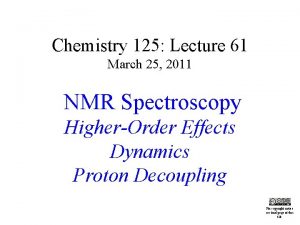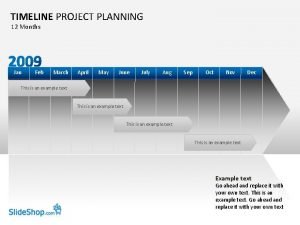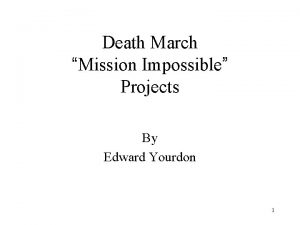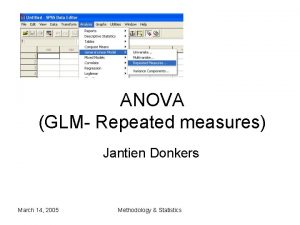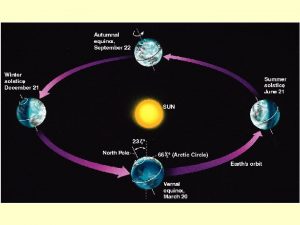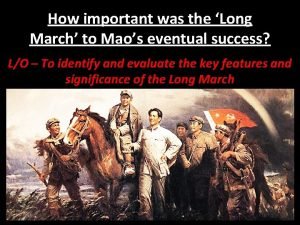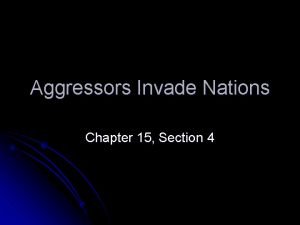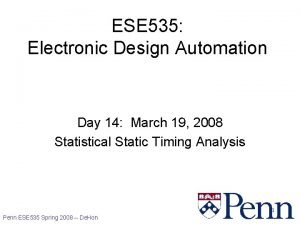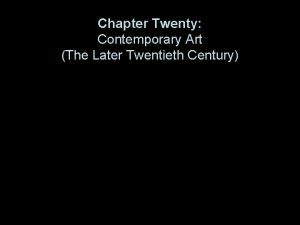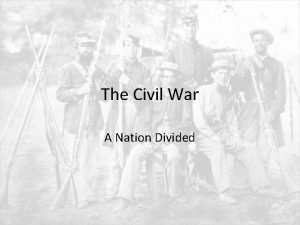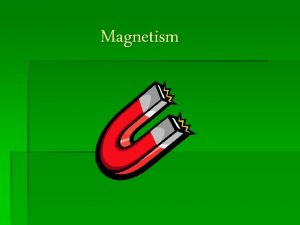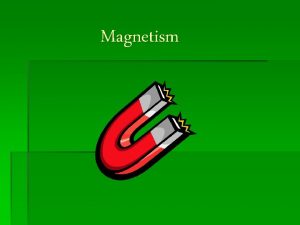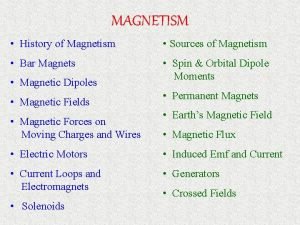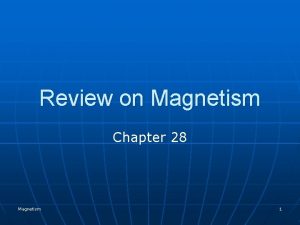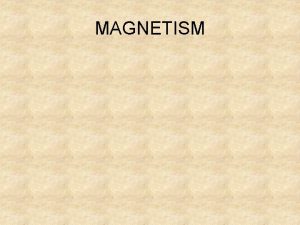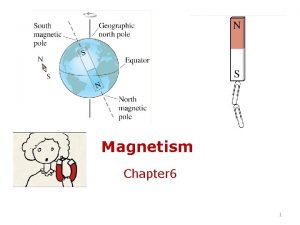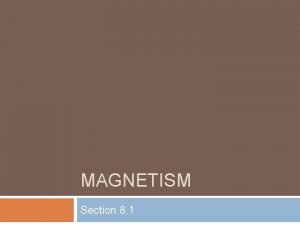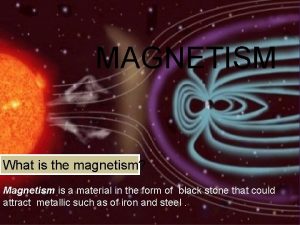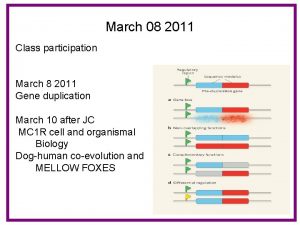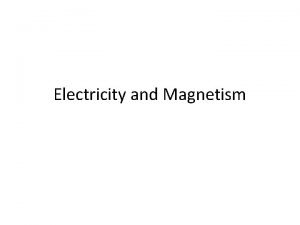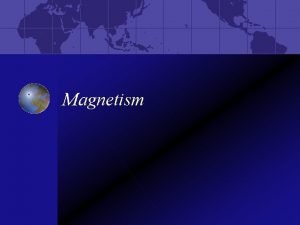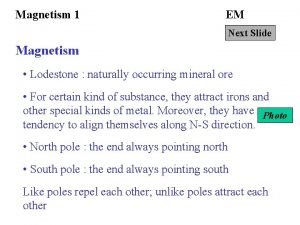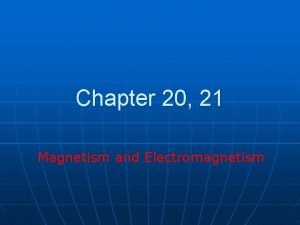Magnetism March 8 2011 Magnetism Overview l Magnetism









































- Slides: 41

Magnetism March 8, 2011

Magnetism Overview l Magnetism is an extremely diverse topic l You probably think of bar magnets and refrigerator doors, but we will also look at horseshoe magnets, magnetic coils, and machines like mass spectrometers

Magnetic Fields l ALL magnets are dipoles (“two poles”) l The each have a North and a South pole l You can never have an isolated north or south pole magnet

Magnetic Fields l EVERY magnet creates a magnetic field l UNLIKE electric fields—which can extend into infinity— magnetic fields form in loops l The loops point AWAY from the north pole and TOWARDS the south pole

Magnetic Fields l Just like we can talk about the electric field at a certain point, we can talk about the magnetic field at a certain point. l Magnetic fields are VECTORS and a represented by the letter “B” l Magnetic fields can be pointed out of or into the page Out (picture it’s the head of an arrow pointing towards you) In (picture it’s the tail of an arrow pointing away from you)

Long, Straight Current-Carrying Wires l Bar magnets aren’t the only objects that can create magnetic fields. l Long, straight, current-carrying wires create magnetic fields that loop around the wire in concentric circles.

Long, Straight Current-Carrying Wires l Right-hand rule– To find the direction of the B field produced by long, straight, current-carrying wires: l Pretend you are holding the wire with your right hand. Point your thumb in the direction of the current. Your fingers wrap around your thumb the same way that the magnetic field wraps around the wire.

Long, Straight Current-Carrying Wires l A wire is directed perpendicular to the plane of this page (that is, it’s coming out straight toward you). The current in this wire is flowing out of the page. What does the magnetic field look like?

Long, Straight Current-Carrying Wires l What does the magnetic field look like around a wire in the plane of the page with current directed upward?

Long, Straight Current-Carrying Wires l B is the magnitude of the magnetic field l μ 0 is a constant called the “permeability of free space” (μ 0 = 4π × 10− 7 T m/A) l I is the current flowing in the wire l r is the distance from the wire.

Moving Charged Particles l The whole point of defining a magnetic field is to determine the forces produced on an object by the field l We are going to focus on the forces produced BY magnetic fields ON charged particles, including both isolated charges and current-carrying wires. l A magnetic field exerts a force ONLY on a charged particle IF that particle is MOVING. l A magnetic field DOES NOT exert a force on a STATIONARY charged particle.

Moving Charged Particles F force exerted on the particle q charge on the particle v multiplied by the velocity of the particle B the magnitude of the magnetic field

Moving Charged Particles The equation will also be seen as F = qv. B(sin θ) The θ refers to the angle between the velocity vector of your particle and the direction of the magnetic field. If a particle moves in the same direction as the magnetic field lines, θ = 0°, sin 0° = 0, and that particle experiences no magnetic force! Normally, you will not need to worry about this “sin θ” term, because the angle will either be zero or 90°. BUT, if a problem explicitly tells you that your particle is not traveling perpendicular to the magnetic field, then you will need to throw in this extra “sin θ” term.

Moving Charged Particles Right-hand rule—To find the force on a charged particle: Point your right hand, with fingers extended, in the direction that the charged particle is traveling. Then, bend your fingers so that they point in the direction of the magnetic field. If the particle has a POSITIVE charge, your thumb points in the direction of the force exerted on it. If the particle has a NEGATIVE charge, your thumb points opposite the direction of the force exerted on it.

Moving Charged Particles Right Hand Rule Direction of Velocity force

Moving Charged Particles

Moving Charged Particles a = 1. 8 × 1017 m/s 2 Into the page


Moving Charged Particles Can a magnetic field do work on a particle? Never! The magnetic force is always perpendicular to the particle’s velocity vector.

Magnetic Force on a Wire A current is simply the flow of positive charges If we put a current-carrying wire in a magnetic field, we have placed moving charges in the field, and These charges experience a force. The wire can be pulled by the magnetic field!

Magnetic Force on a Wire Remember that conventional current is the direction in which POSITIVE charges will flow…

Mass Spectrometry When a charged particle enters a magnetic field it wants to move in a circle a charged particle, traveling perpendicular to a uniform magnetic field, will follow a circular path

Mass Spectrometry-ORGO CHEM! A mass spectrometer is a device used to measure the mass of a particle You can measure the distance it takes for the particle to hit the wall, plug it into the radius equation and solve for the mass

RHR-Ex

MC Practice There is a counterclockwise current I in a circular loop of wire situated in an external magnetic field directed out of the page as shown above. The effect of the forces that act on this current is to make the loop (A) expand in size (B) contract in size (C) rotate about an axis perpendicular to the page (D) rotate about an axis in the plane of the page (E) accelerate into the page

MC Practice Which of the paths above represents the path of an electron traveling without any loss of energy through a uniform magnetic field directed into the page? (A) A (B) B (C) C (D) D (E) E

MC Practice Two long, parallel wires, fixed in space, carry currents I 1 and I 2. The force of attraction has magnitude F. What currents will give an attractive force of magnitude 4 F? (A) 2 I 1 and ½I 2 ( B) I 1 and ¼I 2 (C) ½I 1 and ½I 2 (D) 2 I 1 and 2 I 2 (E) 4 I 1 and 4 I 2

MC Practice A wire in the plane of the page carries a current directed toward the top of the page as shown above. If the wire is located in a uniform magnetic field B directed out of the page, the force on the wire resulting from the magnetic field is (A) directed into the page (B) directed out of the page (C) directed to the right (D) directed to the left (E) zero

MC Practice The direction of the magnetic field at point R caused by the current I in the wire shown above is (A) to the left (B) to the right (C) toward the wire (D) into the page (E) out of the page

MC Practice Two long, parallel wires are separated by a distance d, as shown above. One wire carries a steady current I into the plane of the page while the other wire carries a steady current I out of the page. At what points in the plane of the page and outside the wires, besides points at infinity, is the magnetic field due to the currents zero? (A) Only at point P (B) At all points on the line SS‘ (C) At all points on the line connecting the two wires (D) At all points on a circle of radius 2 d centered on point P (E) At no points

MC Practice An electron is in a uniform magnetic field B that is directed out of the plane of the page, as shown. When the electron is moving in the plane of the page in the direction indicated by the arrow, the force on the electron is directed a. toward the right b. out of the page c. into the page d. toward the top of the page e. toward the bottom of the page

MC Practice An electron moves to the right in a uniform magnetic field that points into the page. What is the direction of the electric field that could be used to cause the electron to travel in a straight line? (A) down toward the bottom of the page (B) up toward the top of the page (C) into the page (D) out of the page (E) to the left

Induced EMF & Flux Electromagnetic induction—when a changing magnetic field strength CREATES an electric current Current flows in a circuit when there is a potential difference between the two ends of the circuit. Usually, we need a battery to create this potential difference. But we don’t have a battery. Changing magnetic field is doing the same thing as a battery would. Instead of talking about voltage of the battery, we talk about the “voltage” created by the changing magnetic field. The technical term— Induced EMF: The potential difference created by a CHANGING a magnetic field that causes a current to flow in a wire. EMF stands for Electro-Motive Force.

Induced EMF & Flux Magnetic Flux: The number of magnetic field lines that pass through an area 1 Weber = 1 T m 2

Induced EMF & Flux What is the magnetic flux in the set-up below?

Induced EMF & Flux Calculate the flux through a loop of radius 0. 2 m where the magnetic field is that of the Earth, B = 5 × 10− 5 T. KEY POINT: Only a changing magnetic flux creates an induced EMF.

Induced EMF & Flux

Faraday’s Law ε is the induced EMF N is the number of loops you have (in all of our examples, we’ve only had one loop) ∆t is the time during which your magnetic flux, ΦB, is changing.

Lenz’s Law When we induce a current in a wire, Lenz’s Law helps us determine the direction of the current. When a current flows through a loop, that current creates a magnetic field The current that is induced will flow in such a way that the magnetic field it creates points OPPOSITE to the direction in which the already existing magnetic flux is changing.

Lenz’s Law

Induced EMF in a Rectangular Wire
 Poland national anthem lyrics
Poland national anthem lyrics March 25 2011
March 25 2011 Deficiency of
Deficiency of French revolution women's march
French revolution women's march Geogrphic
Geogrphic Grihalakshmi magazine march 2019
Grihalakshmi magazine march 2019 March 2 success.com
March 2 success.com Jan feb mar
Jan feb mar Happy wednesday march
Happy wednesday march March of progress view
March of progress view March 5 2021
March 5 2021 Patrick royston
Patrick royston Months of autumn
Months of autumn Sigma gamma rho march of dimes
Sigma gamma rho march of dimes Death march edward yourdon
Death march edward yourdon Sherman's march to the sea route
Sherman's march to the sea route 1965 march
1965 march 20 mile march
20 mile march Slice march
Slice march March
March Colguen les gents ab alegria festes
Colguen les gents ab alegria festes The proclamation of the kingdom
The proclamation of the kingdom 21 march equinox
21 march equinox Ccp
Ccp March madness banner
March madness banner There's a royal banner given for display
There's a royal banner given for display Chapter 31 section 4 aggressors invade nations
Chapter 31 section 4 aggressors invade nations Nine line medevac
Nine line medevac Where was van gogh born
Where was van gogh born Entertainment identifier registry
Entertainment identifier registry 535 before 14 march
535 before 14 march What is ngo
What is ngo Sherman's march to the sea
Sherman's march to the sea Current events quiz
Current events quiz March on the pentagon 1967
March on the pentagon 1967 March 7, 2012
March 7, 2012 March kindergarten newsletter
March kindergarten newsletter January february march
January february march Source
Source Bingo bins mortdale
Bingo bins mortdale Performance art
Performance art Sherman's march significance
Sherman's march significance

